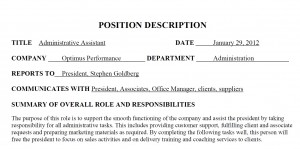Clarifying performance expectations of employees can have a huge impact on employee engagement and productivity. I like to compare this to sports because all the players and coaches know and understand clearly the rules of the game and the factors that constitute to success or failure. The key indicators of performance are constantly being measured and fed back to the players and coaches.
But in organizations this is not always the case and often people do not know if they are succeeding and meeting their bosses expectations. Even if they are told when something is not right or needs improvement this does not mean that expectations of successful performance are clear.
Setting clear expectations does not have to be a long and arduous exercise. The important thing is to get started and communicate the expectations to those concerned.
Start with a good job description
 You can begin the process of clarifying expectations by write a good job description. Refer to my previous blog and video that covers this and also download a job description template and a sample job description..
You can begin the process of clarifying expectations by write a good job description. Refer to my previous blog and video that covers this and also download a job description template and a sample job description..
Identify high payoff activities
From the job description put a star next to the most important tasks. These are often referred to as high payoff activities. These can then be defined as performance standards or expectations.
Define the performance standard or expectation
In my example job description, I wrote a task for preparing PowerPoint presentations. An example performance standard for this task could be;
PowerPoint presentations are aesthetically pleasing and use a well balanced color scheme that reflects our company branding. The presentations communicate the message dynamically using 70-80% images or graphics and words are at least 24 pts or larger. This gives a pretty clear picture of what is expected but can be further enhanced with the measurement method.
Choose a measurement method
A way of measuring each standard must be determined. When establishing a performance standard for the PowerPoint presentation example, it is recommended to use an example such as a previous PowerPoint presentation or choose an external reference source that meets the criteria.
Some performance standards are easier than others to define and measure. For example measuring the prospecting activity of a salesperson might be fairly simple to measure using a CRM software but the task of relationship building might be more difficult. However make measuring of performance as simple and easy as possible otherwise this could stand in the way of actually clarifying expectations.
Track and feedback
It is also important to provide regular feedback of performance against the standards or expectations. This could be statistical in the case of prospecting activities or through discussion and examination of the work output for the PowerPoint example. Either way, it is important to meet regularly with the employee to discuss their performance against the established standards. This way communication improves and the employee gets to clarify any questions or possible misunderstandings. These meetings also provide an opportunity to set performance improvement goals for below standard performance but also to raise the bar on well performed tasks. How can the employee bring their PowerPoint presentation designs to the next level? How can the salesperson get better results from their prospecting activities?
Thus these performance review or appraisal meetings should occur at least once a quarter or even once a month. I the case of new employees it might even be once a week for the first three months. A simple form can be designed to keep track of each review meeting and add notes..
Be committed
Committing to this simple process will greatly benefit the employee, their boss and the organization. It will also help teamwork as each person will know what is expected of their teammates. In a future article and video I will cover how to provide proper feedback to employees during these sessions.
Stephen Goldberg